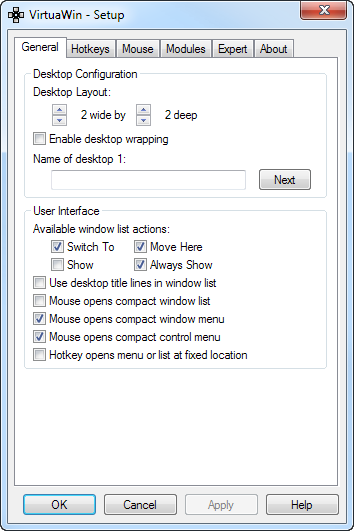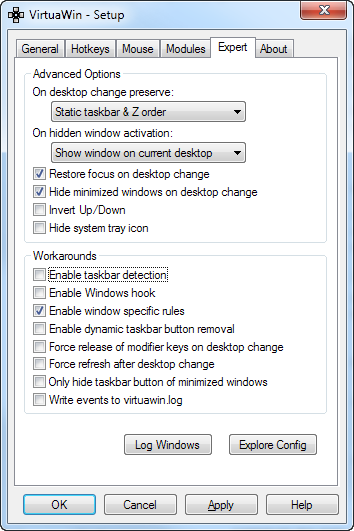When I covered Dexpot some time ago, readers Colugo and Mick were quick to point me in the direction of VirtuaWin as a lightweight, fast alternative virtual desktop software. Encouraged by their feedback, I decided to take VirtuaWin on a thorough spin.
Look & Feel
VirtuaWin can best be described as "sparse". It has been a while since I used such a tiny application – the portable version weighs in at 145KB. If we’d still be using floppies, I’d have no trouble carrying VirtuaWin on my nerdy "great utilities" floppy. The flip side of that tiny footprint is that it has no bells and whistles; you won’t find any funky 3D-looking desktop transitions, or any other trippy graphics for that matter.
The main UI you’re going to get consists of a tiny system tray icon which represents the currently active desktop in the default 2x2 configuration:
In my case, it’s the top-left desktop.
Configuration
As you may expect, the main configuration interface looks quite utilitarian:
You can configure the "shape" of your virtual desktop space, i.e, set how many desktops the "width" and "height" should consist of. If you decide to change the default 2x2 config, the system tray icon turns into a number rather than a visual square showing the currently active desktop.
The hotkeys tab is where all the action takes place:
The list of available actions is so long, it actually exceeds the area of the window. That’s a good example of VirtuaWin’s minimalistic approach. Out of a zillion possible actions, the application only comes with six pre-configured hotkeys. The rest is up to you. You can use VirtuaWin to make windows always-on-top, temporarily pull a window into the current desktop and then "dismiss" it back to the one it came from, and perform numerous other operations.
Performance
On my mid-range computer, switching between desktops was very fast. There was one area of noticeable lag, though: My "main" desktop had nine open windows (and thus, nine taskbar icons). When switching to another desktop, the windows would quickly disappear. They would also quickly reappear when I switched back, but the taskbar icons would take several more seconds to reappear. The lag was noticeable, with the last icons popping up on the taskbar about four seconds after I switched back to the main desktop.
As VirtuaWin doesn’t even attempt to provide any flashy graphical effects, I can’t compare it to Dexpot’s cool 3D-looking transitions. I would expect it to be ultra-snappy, and if you don’t mind the taskbar issue, it does feel quite quick. The Expect configuration tab contains several workarounds, including a couple of taskbar specific options:
Playing with these options made no noticeable difference in the lag issue. One interesting option in the Expert tab is "Hide system tray icon". I guess this one comes in handy for sneaky employees.
Usability & Extensibility
One graphical option that’s sorely lacking is a graphical display of all of your desktops and the windows they contain. I guess that’s a pretty demanding operation which doesn’t mesh well with VirtuaWin’s general minimalism. Fortunately, you can always extend and customize your VirtuaWin installation using so-called Modules, which are basically just plug-ins.
Specifically, there’s a module called VWPreview which provides a basic graphical preview feature, along with some equally-based graphical transition effects. The effects were nothing to write home about, but the preview looked like this on my system:
That’s just one pane (I had two 24" monitors, creating a desktop that’s a tad too wide for a screenshot), but you get the general idea.
Bottom Line
This is one for the minimalists. If there was no irritating taskbar lag, I would bill it as a higher-performance Dexpot alternative. As it is, I cannot honestly say it feels faster, at least on my own system. Both Dexpot and VirtuaWin are very capable applications, each in their own way. Let us know what you think of VirtuaWin or if you prefer one of the alternative apps.
Is there other must-have virtual desktop software you think I should review? Or do you know of a way to make VirtuaWin feel faster? Let me know in the comments.






